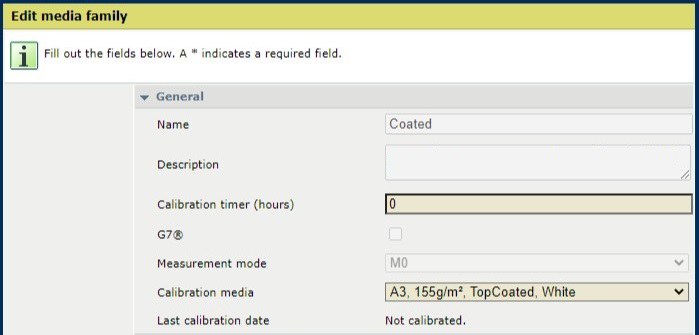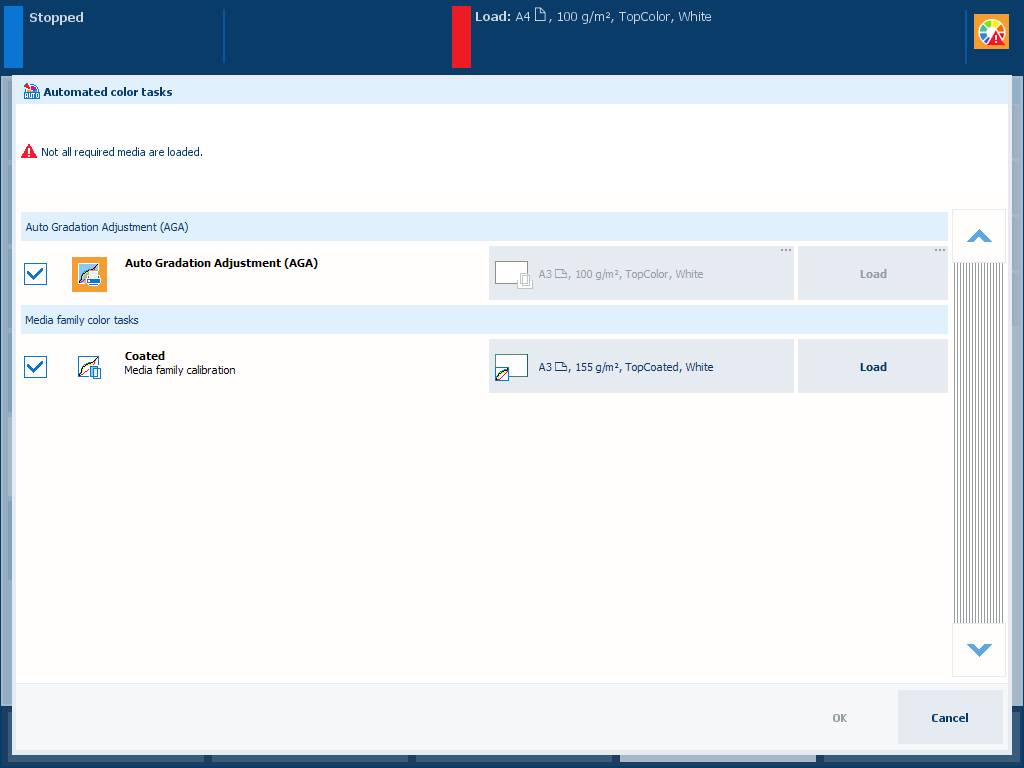

It is important to perform the appropriate calibration procedures regularly. It is possible to perform each calibration procedure separately. However, to ease the process of calibration, PRISMAsync Print Server offers an automated procedure. When you perform the automated color tasks, the calibration procedures will be carried out automatically in the correct order and with limited operator interaction. The automated color tasks include:
automatic gradation adjustment;
shading correction;
media family calibration;
Idealliance® G7® Grayscale test.
It is important to define the settings for the automated color tasks in the Settings Editor.
Open the Settings Editor and go to: .
 [Color calibration] tab
[Color calibration] tabGo to the [Automated color tasks] section.
 [Automated color tasks] section
[Automated color tasks] sectionWith the [Perform the Auto Gradation Adjustment calibration] setting, you can determine when the automatic gradation adjustment is performed.
 [Perform the Auto Gradation Adjustment calibration] setting
[Perform the Auto Gradation Adjustment calibration] settingIf you want to perform the automatic gradation adjustment every time you perform the automated color tasks, select [Always].
If you want to perform the automatic gradation adjustment after a set time, select [Only if the timer expired]. Go to to set the timer value. It is recommended to set the timer value so that the automatic gradation adjustment is performed once a day.
The advice is to always perform the automatic gradation adjustment calibration within the automated color tasks.
Use the [Perform the Idealliance® G7® Grayscale test] setting to define whether the Idealliance® G7® Grayscale test is performed after a G7® media family calibration.
 [Perform the Idealliance® G7® Grayscale test] setting
[Perform the Idealliance® G7® Grayscale test] settingUse the [Print the Idealliance® G7® Grayscale test report] setting to indicate if you want to print the Idealliance® G7® Grayscale test report after the Idealliance® G7® Grayscale test is performed.
 [Print the Idealliance® G7® Grayscale test report] setting
[Print the Idealliance® G7® Grayscale test report] settingYou can also download a detailed report of the performed Idealliance® G7® Grayscale test in the Settings Editor: .
The result of every Idealliance® G7® Grayscale test is retained for four weeks. The last 100 reports can be downloaded.
 [Color configuration] section
[Color configuration] sectionUse the [Print the Automated color tasks report] setting to indicate if you want to print the automated color tasks report after the automated color tasks are performed.
 [Print the Automated color tasks report] setting
[Print the Automated color tasks report] settingYou can also download a detailed report of the performed automated color tasks in the Settings Editor: .
The result of every automated color task is retained for four weeks. The last 100 reports can be downloaded.
 [Color configuration] section
[Color configuration] sectionUse the [Determine which media is used for media family calibration] setting to define which media you want to use for the media family calibration performed in the automated color tasks.
 [Determine which media is used for media family calibration] setting
[Determine which media is used for media family calibration] settingIf you use a specific media most of the time, select [Use default calibration media].
Go to to set this specific media as the default calibration media.
If you use multiple media, [Use any media from the media family] is more convenient for calibration. In this case, you do not have to replace media in the paper trays.
Use the [Determine which media families to calibrate] setting to define which media family calibration procedures are included in the automated color tasks.
 [Determine which media families to calibrate] setting
[Determine which media families to calibrate] settingIf you have many media families, calibration takes a lot of time and effort. To make the calibration process more efficient, you can select [Media families for which media are loaded and require calibration].
Then you only have to calibrate media that you are going to use and that require calibration.
It is advised to put all the media you need for the coming jobs in the trays before printing. This way, you can be sure that all necessary calibrations are carried out.
If you want to calibrate all media families at once, select [All media families that require calibration].
It is the easiest way to ensure that all media families are calibrated. If you have more media families than paper trays, you need to perform the automated color tasks more than once.
In you want media family calibration to be performed within the automated color tasks, you need to adjust the media family calibration timer.
By default, the calibration timer for a media family is disabled (set to 0). If the calibration timer for a media family is disabled, the media family calibration will not be performed as part of the automated color tasks.
To change the media family calibration timer, go to: . It is recommended to set the timer value so that the media family calibration is performed once a day.
 Edit media family
Edit media familyUse the [Shading correction mode] setting to select the mode for shading correction during automated color tasks.
This setting is applicable if the sensing unit is present in your printer configuration.
 [Shading correction mode] setting
[Shading correction mode] settingIf you use the [Quick] mode, the shading correction procedure with the sensing unit takes two minutes.
If you use the [Full] mode, the shading correction procedure with the sensing unit takes four minutes.
For all automated color tasks (except for shading correction), the inline spectrophotometer is used. Use the following media for the automated color tasks:
Media sizes: A3/11 inch x 17 inch, SRA3/12 inch x 18 inch, 330 mm x 483 mm/13 inch x 19 inch
Media weights for media type uncoated: 64 g/m² - 300 g/m² (17 lb bond - 110 lb cover)
Media weights for media type coated: 70 g/m² - 300 g/m² (19 lb bond - 110 lb cover)
i1Pro3 spectrophotometer (i1Pro2 also supported) when you want to perform the shading correction too.
Check if you have defined the required settings for the automated color tasks in the Settings Editor.
If necessary, load the calibration media.
Go to the control panel and touch .
 The automated color tasks
The automated color tasksTouch [Automated color tasks].
You see the calibration tasks which will be performed according to the settings you defined in the Settings Editor.

If preferred, deselect the task you do not want to perform.
Touch [OK] to start the first procedure.
Follow the instructions on the control panel.
After the automated color tasks have been finished, an overview of the performed tasks are presented on the operator panel. When a task has failed, it is marked with a warning sign. Dependent on the setting in the Settings Editor, a report with the overview of the tasks will be printed.
You can perform the failed task again via the separate procedure to obtain more information about the cause of the failure.